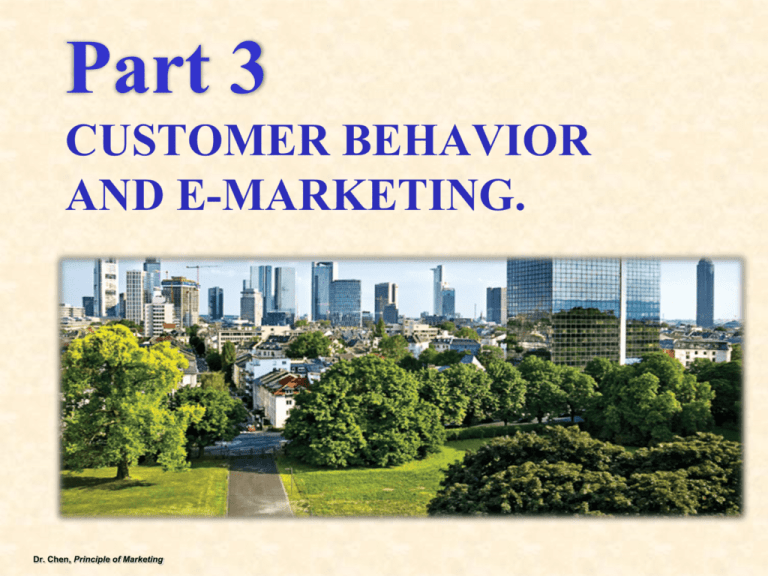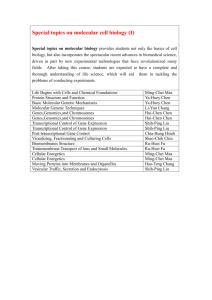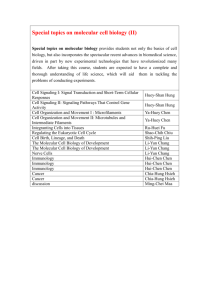
Part 3
CUSTOMER BEHAVIOR
AND E-MARKETING.
Dr. Chen, Principle of Marketing
6: Consumer Buying Behavior
7: Business Markets and
Buying Behavior
8: Reaching Global Markets
9: Digital Marketing and Social
Networking
Dr. Chen, Principle of Marketing
Chapter 7
Business Markets and Buying
Behavior
Professor Jason C. H. Chen, Ph.D.
School of Business Administration
Gonzaga University
Spokane, WA 99258
chen@jepson.gonzaga.edu
Dr. Chen, Principle of Marketing
Learning Objectives
To distinguish among the various types of business
markets
To identify the major characteristics of business
customers and transactions
To understand several attributes of demand for
business products
To understand the buying center and the stages of the
business buying decision process and the factors that
affect this process
To describe industrial classification systems, and
explain how they can be used to identify and analyze
business markets
Dr. Chen, Principle of Marketing
4
Business Markets
Business markets consist of individuals, organizations,
or groups that purchase a specific kind of product for
one of three purposes:
Resale
______
Direct use in producing other products
Use in general daily operations
Important structural and behavioral differences:
A company that markets to another company must be aware
of how its product will affect other firms in the marketing
channel such as resellers and other manufacturers.
Range of forms that business marketing takes
From long-term buyer-seller relationships
To quick exchanges of basic products at competitive market
prices
Dr. Chen, Principle of Marketing
5
Categories of Business Markets
1. Producer
2. Reseller
3.
Government
___________
4.
Institutional
___________
Dr. Chen, Principle of Marketing
6
Producer Markets
Individuals and business organizations that
purchase products to make profits by using
them to produce other products.
Producer markets include:
Buyers
of raw materials
Purchasers of semi-finished and finished items, used
to produce other products
Broad array of industries such as agriculture,
forestry, fisheries, mining, construction etc.
Dr. Chen, Principle of Marketing
7
Reseller Markets
Reseller markets consist of intermediaries
(wholesalers and retailers) that buy finished
goods and resell them for a profit
Do not change the physical characteristics of
the products they handle
All products sold to consumer markets are first
sold to reseller markets
Dr. Chen, Principle of Marketing
8
Reseller Markets
Intermediaries
Wholesalers Purchase products for resale to:
• ____________–
• Retailers and other wholesalers
• Producers
• Governments
• Institutions
Retailers Purchase products and resell them to final consumers
• _________-
Considerations in purchase decision making
• Level of demand – determine the quantity and the price at which
the products can be resold
• Supplier’s ability to provide adequate quantities when and where
needed
• Amount of space required to handle a product relative to its
potential profit
placing orders
• Ease of ________
Dr. Chen, Principle of Marketing
9
Government Markets
Federal, state, county, and local governments
Accounts
for more than 40 percent of the total gross
domestic product (GDP)
Accountable to the public
Result
in complex buying procedures
Governments advertise purchase needs by
releasing bids or negotiated contracts
Dr. Chen, Principle of Marketing
10
Institutional Markets
Organizations with charitable, educational,
community, or other nonbusiness goals
Have different goals and fewer resources than
other type of organizations
Marketers
Dr. Chen, Principle of Marketing
may use special efforts to serve them
11
Figure 7.1 - Dimensions of Business Customers and
Business Transactions
D1
D2
D4
Dr. Chen, Principle of Marketing
D3
D5
12
D1 - Characteristics of Transactions
with Business Customers
Transactions between businesses differ from
consumer sales in several ways
larger
orders tend to be much ______
committee
Purchases tend to be made by ________
Discussions and negotiations can require
considerable marketing time and selling effort
Reciprocity is an arrangement unique to
business markets in which two organizations
agree to buy from each other
Business
Agreements that threaten competition are illegal but
a certain amount still occurs
Dr. ©
Chen,
of Marketing
Copyright
2014Principle
South-Western,
Cengage Learning. ALL RIGHTS RESERVED.
8-13
D2 - Attributes of Business Customers
Business customers differ from consumers
Better
informed about the products they purchase
Demand detailed information about:
Product’s functional features
Technical specifications
Personal
goals influence business buying behavior
Partnerships - Suppliers and their customers build
and maintain mutually beneficial relationships
Dr. Chen, Principle of Marketing
14
D3 – Primary Concerns of Business Customer
When making purchasing decisions, business customers
take into account a variety of factors:
Price - Influences operating costs and costs of goods
______
sold
Affect selling price, profit margin, and the ability to
compete
Product quality - Firms establish standards for products
and buy them on the basis of specifications
Service - Influences buyers’ costs, sales, and profits
Supplier ____________
relationships - Buyers reduce their search
efforts and uncertainty about prices by building trust
with suppliers
Dr. Chen, Principle of Marketing
15
D4 - Methods of Business Buying
Description
Used when products are standardized such as agriculture products
(their size, shape, weight and color)
Inspection
• Used when products have unique characteristics and may vary with
regard to condition
• They can differ depending on how they were used and for how long
Sampling
• Used for homogeneous products when examining the entire lot
is not feasible such as grain (not physically or economically
feasible)
Negotiation
• Used commonly for one time projects and very large or
expensive purchases
Dr. Chen, Principle of Marketing
16
D5 - Types of Business Purchases
New-task purchase
• Initial purchase of an item to be used to perform a
new job or solve a new problem
Straight rebuy purchase
• Purchase of the same products routinely under
approximately the same terms of sale
Modified rebuy purchase
• New-task purchase that is changed on subsequent
orders, or when requirements with a straight rebuy
purchase are modified
Dr. Chen, Principle of Marketing
17
Demand for Business Products
Derived demand
• Demand for business products that stems from demand
for consumer products
Inelastic demand
• Price increase or decrease does not significantly alter
demand for a business product
Joint demand
• Using two or more items in combination to produce a
product
Fluctuating demand
• Subject to fluctuations as business products are derived
from consumer demand
Dr. Chen, Principle of Marketing
18
Business Buying Decisions
Business (organizational) buying behavior
refers to the purchase behavior of producers,
government units, institutions and resellers
Some purchasing factors are the same as the
consumer market but some are unique to business
markets
We will first look at the buying center which is a
group of people within an organization who make
business purchase decisions
Then we will focus on the stages of the buying
decision process and the factors that affect it
Dr. ©
Chen,
of Marketing
Copyright
2014Principle
South-Western,
Cengage Learning. ALL RIGHTS RESERVED.
8-19
The Buying Center
The people within an organization who make
business purchase decisions are called the buying
center and includes the following roles:
Users – members who frequently initiate the purchase,
use the product and evaluate the product
Influencers – technical personnel who develop the
specifications and evaluate alternative products
Buyers – select suppliers and negotiate terms
Deciders – actually choose the products
Gatekeepers – control the flow of information to and
among people who occupy other roles in the buying
center
Dr. ©
Chen,
of Marketing
Copyright
2014Principle
South-Western,
Cengage Learning. ALL RIGHTS RESERVED.
8-20
Buying Center (cont.)
Number and structure are affected by:
Organization’s
size and market position
Volume and types of products being purchased
Firm’s overall managerial philosophy
Size is influenced by:
Stage
of the buying decision process
Type of purchase
New-task, straight rebuy, or modified rebuy
larger for a new-task
size is generally _______
purchase than for a straight rebuy.
The
Dr. Chen, Principle of Marketing
21
Buying Decision Process
(or need)
[1]
[2]
[3]
[4]
[5]
(Details see next slides)
Fig. 7.2 Business (Organizational) Buying Decision Process and Factors That May Influence It.
Dr. Chen, Principle of Marketing
8-22
Stage 1: Problem Recognition
recognize a problem
One or more individuals __________
or need exists
Could be individuals in the buying center such as
users, influencers or buyers who recognize the need
or problem
Problems or needs could be identified by external
sources such as sales representatives or
advertisements
May arise under a variety of circumstances
When machines malfunction
When an existing product is modified
When introducing new products
Dr. ©
Chen,
of Marketing
Copyright
2014Principle
South-Western,
Cengage Learning. ALL RIGHTS RESERVED.
8-23
Stage 2: Develop Product
Specifications to Solve Problem
The development of product specifications
assess
requires the buying center participants ______
determine what is
the problem or need and _________
necessary to resolve or satisfy it
Users and influencers often provide information
and advice
By assessing and describing needs, the
organization should be able to establish product
specifications
Dr. ©
Chen,
of Marketing
Copyright
2014Principle
South-Western,
Cengage Learning. ALL RIGHTS RESERVED.
8-24
Stage 3: Searching for and Evaluating
Potential Products and Suppliers
Search activities
Looking in company files and trade directories
Contacting suppliers for information
Soliciting proposals from known vendors
Examining online and print publications
Value analysis is an evaluation of each component
______
of the potential purchase
Examines quality, design, materials etc
Vendor analysis is a formal, systematic evaluation
________
of current and potential vendors
Examines price, product quality, delivery service, product
availability and overall reliability
Dr. Chen, Principle of Marketing
25
Stage 4: Select Product and Supplier
and Order Product
The fourth stage is to select the product to be
purchased and the supplier or suppliers
Multiple Sourcing – when the buyer selects and uses several
suppliers
Sole Sourcing – when only one supplier is selected
Which one is better and pros/cons?
Sole sourcing has historically been discouraged except in the cases
where a product is only available from one company.
This stage is where the actual purchase takes place and
the following details finalized
Terms and credit arrangements
Delivery dates and methods
Technical assistance arrangements
Dr. ©
Chen,
of Marketing
Copyright
2014Principle
South-Western,
Cengage Learning. ALL RIGHTS RESERVED.
8-26
Stage 5: Evaluating the Performance of
Product and Supplier
Product is evaluated by comparing it with the
specifications
_____________
Specifications must be adjusted if the performance fails to
adequately solve the problem or satisfy the need, even if the
product specifications are met
Supplier's performance is evaluated
Business purchaser seeks corrective action from the supplier
or searches for a new one if the performance is inadequate
These 5 steps are used primarily for _____-task
new
purchases
Dr. Chen, Principle of Marketing
27
Influences on the Business Buying
Decision Process
[1]
[2]
Dr. ©
Chen,
of Marketing
Copyright
2014Principle
South-Western,
Cengage Learning. ALL RIGHTS RESERVED.
[3]
[4]
8-28
Environmental Factors
Environmental factors that influence buying decisions
include:
Competitive and economic factors
Political forces
Legal and regulatory forces
Technological changes (e.g., Intenet)
Sociocultural issues
uncertainty for an
These factors can generate considerable ___________
organization
Changes in environmental forces can create opportunities
and threats that affect purchasing decisions
Dr. Chen, Principle of Marketing
29
Organizational Factors
Organizational factors that influence the buying
decision process include:
Company’s objectives
Purchasing policies
Resources
Size and composition of the buying center
A firm’s policies may mandate contract lengths that
are undesirable
__________ to many sellers.
Special credit arrangements required by an
organization’s financial resources might affect
purchase decisions
Dr. Chen, Principle of Marketing
30
Interpersonal Factors
Interpersonal factors are the relationships among
people in the buying center
Trust is crucial in collaborative partnerships.
______
When customized products are involve – the buyer may not
see the product until it is finished and must trust that the
producer is creating it to specifications.
Trust and clear communication ensure that all parties
are satisfied with the outcome
Processes may get complicated within the buying
center due to:
Interpersonal dynamics
Varying communication abilities
Dr. Chen, Principle of Marketing
31
Industrial Classification Systems
Information about business customers is based on
industrial classification systems
Standard Industrial Classification (SIC) System was
developed by the federal government but replaced by
NAICS
International Standard Industrial Classification (ISIC)
is used mainly in Europe
North American Industry Classification
System (NAICS)
An industry classification system that generates
comparable statistics among the United States, Canada
and Mexico among the three partners of NAFTA
Dr. ©
Chen,
of Marketing
Copyright
2014Principle
South-Western,
Cengage Learning. ALL RIGHTS RESERVED.
328-32
Difference between NAICS and SIC
Dr. Chen, Principle of Marketing
33
Industrial Classification Systems
Provide a uniform means of categorizing organizations into groups
Best used in conjunction with other types of data to determine
exactly:
How many and which customers a marketer can reach
Approaches to determine the identities and locations of
organizations in specific groups
Use state directories or commercial industrial directories
Use commercial data service
Useful in estimating the purchase potential
Problems with the data include:
Few industries do not have specific designations
Double-counting of shipments may occur
Data may be understated
Significant lag exists between data-collection and the time when the
information is released, therefore, currency of data may suffer
Dr. Chen, Principle of Marketing
34
Video Case 7.1
DALE CARNEGIE FOCUSES ON
BUSINESS CUSTOMERS
Dr. Chen, Principle of Marketing
35
Summary
This case shows how a company that provides a valuable
service thrives in the B2B market. Dale Carnegie was a
successful entrepreneur and speaker famous for his book,
How to Win Friends and Influence People. His self-named
firm trains business people and members of the government
on how to connect with customers and colleagues. Dale
Carnegie focuses on helping companies to develop powerful
business relationships by learning to listen and interact well,
both face-to-face and through digital communications.
Dr. Chen, Principle of Marketing
36
1. How would you apply Dale Carnegie’s methods if you
were trying to make a sale to a company with a large
buying center?
The buying center is the group of people involved in making
such purchase decisions. Dale Carnegie’s philosophy is that
a marketer trying to appeal to a large buying center should
take the time to listen to the concerns of users, influencers,
buyers, deciders, and gatekeepers, connect with all groups,
and address all of their needs.
Dr. Chen, Principle of Marketing
37
2. From a marketing perspective, why would people who
work for the U.S. Department of Veteran Affairs be as
interested in taking a Dale Carnegie course as people who
work for American Express?
Government agencies such as the Department of Veterans
affairs have customers too—the people that they serve.
Because of this, it is important for members of the
government to understand how to connect with their
colleagues and with their constituencies.
Dr. Chen, Principle of Marketing
38
3. Which concerns of business customers should Dale
Carnegie’s marketers pay close attention to when selling
training services to a company like American Express?
Although all four concerns (price, quality, service, and
supplier relationships) may have a role, Dale Carnegie’s
marketers should pay close attention to quality and service.
They may be searching for a great long-term customer
service experience.
Companies want to get the best quality information and
training and may want ongoing support when they deal with
challenging situations and hire new employees.
Dr. Chen, Principle of Marketing
39






